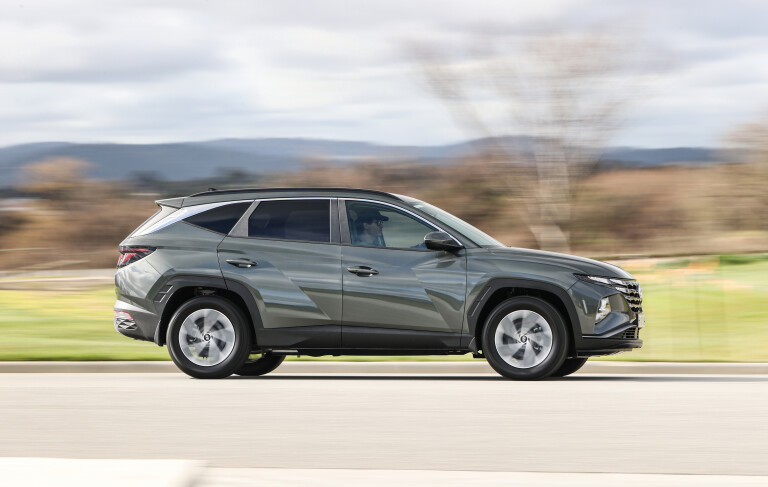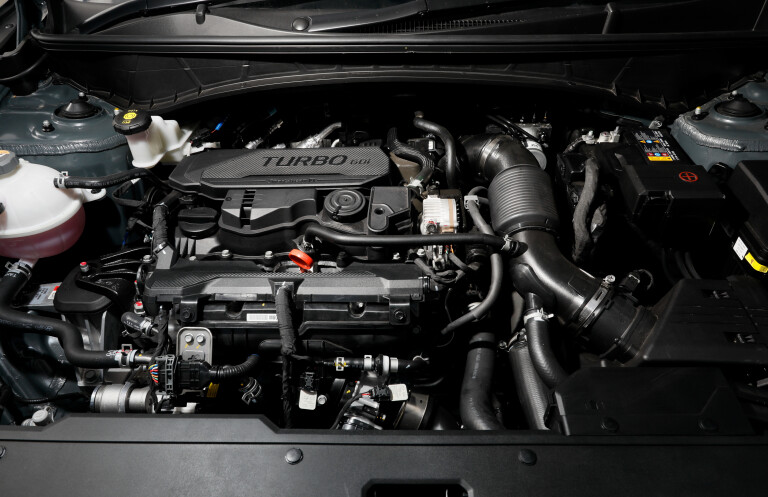
Score breakdown
Things we like
- Improve torque and flexibility over 2.0
- AWD traction welcome around town
Not so much
- Gear-selector pad can be finicky
- Dual-clutch gearbox stumbles at low speed
As far as expectations go, Hyundai's are up there for the all-new Tucson. Chief designer SangYup Lee reckons by dominating in one of the world's largest segments ¬– medium-size SUVs – the sharp-styled Tucson can grow into an icon for the brand. Like the Golf has been for VW. Or the S-Class for Mercedes-Benz.
To prove this sentiment is more than just headline-baiting bravado, Hyundai scaled down the Santa Fe's new N3 platform into two wheelbase options under the Tucson while devising new plug-in and full hybrid powertrains.
This has boosted the model's eco-credentials around the world, except here. Australia's relaxed emissions laws have dropped us down the priority list for hybrid allocation – even though we're told the Kia Sorento lands with the hybrid powertrains soon.

At least this Tucson 1.6 T-GDi variant offers some consolation, given that its new turbocharged 1.6-litre inline-four-cylinder engine is the beating heart of hybrid Tucson powertrains elsewhere.
And while the Tucson's 2.0-litre atmo petrol (which we're running as a long-termer in the Wheels Garage) Smartstream engine re-heats its predecessor with efficiency-enhancing tweaks, the new petrol Smartstream G1.6 has enjoyed a more comprehensive shake-up.
The big news is CVVD. Or Continuously Variable Valve Duration technology. It mechanically slows or quickens the intake cam's lobe relative to shaft speed to keep valves open for as long as needed. The benefit is a smidge more power and curbed thirst.

In numbers, power is up 2kW, from 130kW to 132kW, while torque remains pegged at 265Nm. Claimed fuel consumption on a combined driving cycle drops 0.5L/100km to 7.2L/100km, which is helped by a lighter kerb weight, now 33kg lighter at 1560kg.
Our test returned a 9.2L/100km real-world consumption figure, which is still lower than the 10.4L/100km average achieved by the atmo 2.0 Elite in the Wheels garage.
At $43,000 before on-roads, the Tucson 1.6 adds $4000 to the 2.0-litre petrol offered in mid-level Elite trim, which the petrol turbo enjoys as standard. Larger alloys, all-wheel drive and a seven-speed dual-clutch transmission, comprise the bulk of that price jump.
Meanwhile, the Elite trim includes a slew of mod-cons and safety features. These include front parking sensors with screen guidance, a smart key, digital radio, leather seats, a 10-way power-adjustable driver's seat, heated front seats, dual-zone climate control and a 10.25-inch infotainment screen (up from 8.0-inches).

The upgrade to the 1.6 T-GDi also introduces a gear-selector pad in place of a regular shift lever. Shift paddles hide behind a new generation steering wheel.
The T-GDi also gets a Smart drive mode, which joins Normal, Eco and Sport. Annoyingly, none allow you to hold a gear long enough to overcome gear mapping woes.
Even though the Elite 1.6 upgrades to a wet-clutch DCT, it can suffer from indecisiveness between light tip-in to mid-throttle. Here, it sometimes upshifts early to conserve fuel but then quickly downshifts after realising you want to keep with traffic.
Driveability-wise, three-point turns are also tricky, given the larger-than-average 11.8m turning circle and stress of finding the right button on the gear pad.

On the move, the direct-injected 1.6-litre engine spins smoothly and is flexible with its delivery. It builds torque convincingly from down low, where Hyundai claims peak thrust arrives as early as 1500rpm. Really, though, it feels potent from 2500rpm.
All-wheel drive keeps wheelspin in check off the line. But the traction comes at a price, with extra weight penalising the Tucson over the 80km/h to 120km/h sprint, which takes 6.41sec and a moment longer than some of its turbocharged front-drive rivals – like the Honda CR-V.
Dynamically, Hyundai's decision to endure with a global suspension tune underscores its confidence in the nameplate, even if COVID-19 had some part in preventing local work.

Despite the 235/60 R18 tyres rolling too far over their sidewall in the mid-corner, the front-end remains responsive, guided by steering that, while rubbery just off centre, weighs up nicely in Sport mode and increases in accuracy with more lock.
Upgrades to the standard-fit Nexen Rodian GTX rubber and disc brakes would be the first point of call for a tuned variant to maximise fun. But the strut front and multi-link rear suspension has other priorities.
The damping is expertly judged, maintaining resolute body control while allowing enough travel to glide over undulations. The Elite's big tyres can slap over sharp edges, but overall, the ride is comfortable.

Day-to-day, the Tucson's packaging is excellent, with a spare tyre hidden under the flat-load boot floor and 60/40 split-fold rear seating that can be dropped with rear pull handles make loading a cinch.
Seat comfort and outward vision are good, too. While a full suite of active safety systems works with precision, even if lane-keep assist annoyingly switches on after every start-up.
Although the Tucson 1.6 T-GDi needs to improve transmission response, it is a strikingly styled medium-SUV packing an impressive amount into a comfortable, refined package. However, is it a future icon? Only time will tell.
Hyundai Tucson Elite 1.6 T-GDi Specifications
| Model: | Hyundai Tucson 1.6 T-GDi Elite |
|---|---|
| Engine: | 1598cc |
| Power: | 132kW @ 5500rpm |
| Torque: | 265Nm @ 1500-4500rpm |
| Transmission: | 7 speed dual-clutch |
| Weight: | 1563kg |
| Economy: | 9.2L/100km (tested) |
| Price: | $43,000 (before on-roads) |
| Weight: | 1563kg |
| Economy: | 9.2L/100km (tested) |
| Price: | $43,000 (before on-roads) |
Score breakdown
Things we like
- Improve torque and flexibility over 2.0
- AWD traction welcome around town
Not so much
- Gear-selector pad can be finicky
- Dual-clutch gearbox stumbles at low speed

COMMENTS